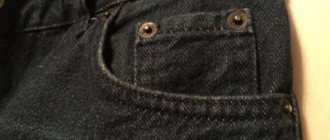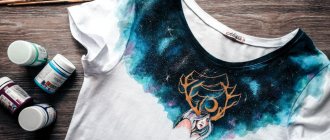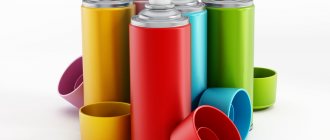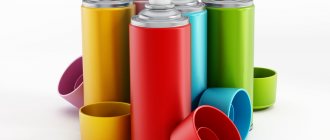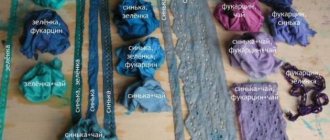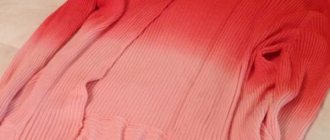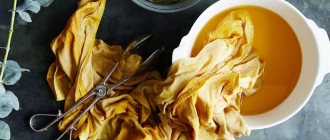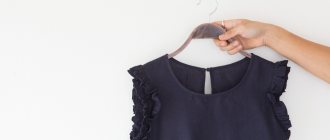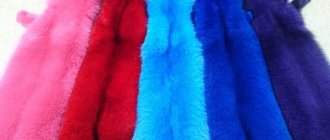How to transform your interior by painting tulle
Tulle and curtains are the accessories that are the first to be noticed by people entering a room. Fabric curtains can either decorate or hopelessly ruin the interior.
Painting curtains a different color quickly and without much effort is one of the acceptable options for transforming the interior. By changing the color scheme of the clothes for the windows and choosing cute little things to match the color, you can get a new solution for your home or work environment.
Painting curtains with your own hands can help if there is no time and money to repair and update the interior, but the “soul asks” for something new. The painting process is economical in all respects:
- no significant funds are required to purchase dyes;
- it is not necessary to waste time waiting and listening to the designer’s recommendations;
- there is no need to spend a long time shopping in search of new curtains;
- Re-staining is possible.
Home conditions are quite suitable for updating your window “wardrobe” yourself. Let's look at this process step by step.
Preparing the fabric
Before painting window curtains, you need to prepare the product. After removing the curtains or tulle from the window, you need to carefully knock them out to get rid of dust and foreign particles. Warm water and detergent are what you will need for this step. The washing solution should not be made too concentrated, otherwise it will be difficult to rinse later. It is advisable to use hand washing or gentle cycle in a washing machine.
A warm temperature (no higher than 40 degrees) is suitable in order not to spoil the fabric and at the same time wash it well. To achieve excellent results, repeat the washing and rinsing procedure several times.
High-quality dyeing of tulle at home can only be done on well-washed fabric. Under no circumstances do the following:
- twisting;
- strong mechanical impact;
- twisting push-up.
This will damage the fabric, and painting the curtains will not be a positive event, but a disappointment.
Dyeing fabrics with natural dyes: step-by-step instructions
How to dye fabric if you only have the contents of the refrigerator and groceries?
The following step-by-step instructions will help you avoid mistakes:
- Grind the coloring ingredient with a knife or grater, if necessary.
- Place in a saucepan and add water in a ratio of 1 to 2.
- Bring to a boil and leave for an hour. For a more saturated pigment, you can leave the liquid overnight.
- Strain the water thoroughly: make sure that there are no small pieces left in it - otherwise they will leave stains on your clothes.
- Prepare a paint fixative: if you are using berry or fruit juice, add half a cup of salt to 2 liters of water, bring to a boil, put a cloth there and boil for an hour. The proportions can be increased according to the size of the item being painted. If you paint with vegetables, spices or herbs, you need a vinegar solution. To prepare it, add four equal portions of water to one part of vinegar, put a cloth there and heat over low heat for an hour.
- After the time has passed, remove the item from the fixative solution and rinse in ice water.
- Dip the fabric into the dye and leave it for a while - the longer it stays there, the richer its final color will be.
When the product dries, the fabric will turn pale. Take this into account and paint the product longer if necessary.
Choosing a dye
After the preparatory stage, you need to decide what color you want to get the textile product. A large selection of aniline dyes sold in retail chains will help you dye nylon mesh or dense fabrics in the desired color. Choose a product that matches the material and intended color.
It is not difficult to color curtains and tulle with purchased dyes; the main thing is to strictly follow all the steps prescribed in the instructions.
But not only aniline agents change the color of window curtains. You can color roller blinds and all other window treatments using available substances that can change the shade of the fabric. This is easy to do using:
- Tea leaves.
- Brilliant greenery (zelenka).
- Potassium permanganate.
- Onion peel.
- Juice of some products (beets, blueberries, blackberries, spinach).
- Coffee.
How can you dye fabric? Learning to understand dyes
Most often, if you ask this question to a sales assistant at a craft supply store, he will recommend acrylic or powder paint. If you ask experienced needlewomen, they will advise using folk remedies. Below we will look at each option in detail so that you can choose the one that suits you.
Acrylic paint
Ideal for creating designs on clothes. Even if you don’t know how to draw, you can use a stencil - this way the drawing turns out clear, without spots, streaks and dirt. Since acrylic dries quickly, you need to ensure that the jar is open for no longer than an hour or use a tube with a tight-fitting lid. You can also lay out the paint on the palette in advance.
If the acrylic has already begun to dry, do not dilute it with water, otherwise the design will crack or peel off after the first wash.
Powder paint (aniline)
Suitable for dyeing natural fabrics: cotton fabric (cotton for short), cotton, wool and silk, but for synthetics it is better to choose something else. Typically, aniline dyes are diluted with water in a ratio of 1 to 30, the clothes are immersed in the prepared solution and begin to “cook” at a temperature of 95 degrees. Upon completion of the process, you need to fix the pigment with salt, the amount of which varies from 2 to 5 spoons, depending on the size of the product and the amount of water.
If you are dyeing wool, add a little more vinegar to the salt, and if you are dyeing cotton, add a little soda. This will allow the dye to be fixed in the texture of the product.
Do not be alarmed if after the first washes the fabric fades - this is normal, since initially it absorbs more dye than necessary.
Stamp ink
Used to leave a label on clothing or mark hotel textiles.
The composition of stamp inks varies, as do the subtleties of use:
- Alcohol based - the fastest drying. After dyeing, the product can be washed many times, even with bleach, without fear that the applied pattern will fade.
- Glycerin - dries very slowly, but is highly resistant to water and shedding. The palette is limited to shades of black, brown and blue.
- Colorless - used for hidden marking of branded textiles, visible only under ultraviolet light.
Reflective paints
Plastisol-based tints are often used by manufacturers of sportswear and footwear to create patterns that will be visible in the dark due to the cumulative effect. During the day, the pattern is practically invisible, but at night or in a club under ultraviolet light it acquires a soft pinkish, yellow, or greenish glow.
There are also luminescent paints, which contain a safe luminous phosphor powder. If it is necessary to reduce the intensity of the glow, the composition can be diluted with colorless clothing varnish. Some paints have fine glitter added. Most often used for painting on cotton clothing: T-shirts, jackets and denim trousers.
Aerosol paints
The aerosol is convenient to use when you need to apply a design through a stencil. The tissue at the site of application becomes stronger and loses elasticity. Best suited for applying patterns to clothes made of leather, faux leather or denim.
Natural dyes
Most spices, vegetables, fruits and berries can be used as a natural dye. You will definitely find something suitable in your kitchen. This is a rather labor-intensive process. It is most often used to dye things that will no longer be washed either by hand or in a washing machine, since dyes behave unpredictably.
Let's look at what products you need to use to get bright shades.
- Red color - juice of beets, blueberries, pomegranates and black currants give colors from dusty pink to deep red, depending on the concentration of the solution.
- The blue color, and therefore blue and purple, can be obtained by using the juice of red cabbage or blackberries.
- Yellow color - juice and skins from bright citrus fruits are suitable.
- Green color is pleasant to the eye; pure green color is quite difficult to obtain from natural products. Some people use elderberries, juniper or spinach. Painting fabric with green gives a more stable and bright result, but you need to work with gloves.
- Orange/amber color - can be obtained from a decoction of onion skins. The same thing that our grandmothers used to color eggs for Easter. And sea buckthorn berries are also suitable.
- Beige and creamy can be obtained from strong coffee or tea.
Painting process
Multi-colored tulle
Preparing fabric for dyeing is a prerequisite when choosing any of the dyes. Only by dyeing clean fabric will you get the desired result. It is not necessary for the fabric to dry completely after washing; slightly damp tulle and curtains will absorb coloring pigments faster.
The color intensity of the product depends on the concentration of the dye and time.
Aniline dyes
When choosing this coloring method, do not experiment; you can effectively paint curtains a different color only by strictly following the instructions. The following options are possible:
- The dye is diluted in a small container until the dye is completely dissolved and poured into the main volume of water, where the tulle is then placed.
- The coloring agent is immediately added to a basin or pan, where warm water is added. The product to be painted is placed in this solution.
Often, dye manufacturers recommend “salting” water with table salt to obtain a durable color. The proportions of water, salt and dye are indicated in the instructions.
Zelenka
Painting the fabric with green paint should be done by those housewives who want to see window decorations in a greenish tint. Dissolve a little green pharmaceutical liquid in warm water and stir the contents of the container evenly. Then place a damp cloth there and leave for a short period of time. You can dye fabric with brilliant green at home evenly, without streaks and stains, if you periodically turn the tulle (curtains, nylon mesh) in a basin.
Potassium permangantsovka
You can paint curtains without much effort and material costs by using potassium permanganate. In this case, you will get a lilac shade. The entire painting process will take very little time, but the result will definitely please you. The principle of coloring is the same as when using brilliant green.
Tea and coffee
To give window curtains a beige or cream color, you can use tea leaves or ground coffee. Dying fabric with tea at home is as easy as using other natural dyes. Two teaspoons of tea leaves or coffee is enough to prepare a coloring solution. They need to be dipped in 1 liter of boiling water, wait until completely dissolved and strain. Then put the material to be painted into this “decoction”.
If the tulle is very large, then increase the proportions of coffee (tea) and water.
Recommendations for dyeing clothes and tulle:
- The most important and main advice. Before you start directly painting clothes, weigh the pros and cons. Amateur painting is always a risk.
- if the fabric is natural, for example: cotton, linen, denim, then, as a rule, dyeing goes well;
- if the fabric is mixed, the color will come out a little paler, for example, it will not be blue, but light blue.
- if the fabric is 100% synthetic, there is a very high risk that the fabric will not dye at all, because with synthetic fabrics, the paint flows off like cellophane, and the product will remain exactly the same shade as before dyeing.
Important! Please note that, unfortunately, at the moment there are more and more cases when the composition that is written on the label does not coincide with reality.
- Decide on a color. We recommend dyeing in colors that are slightly darker than the original shade of the fabric. For example, blue is best painted blue or dark blue. Also, do not forget to take into account the original shade of the item. The ideal option is if they are similar colors. But if you dye white jeans black, you will end up with gray or dark gray, but not black.
- Only judge the final shade on a thoroughly dried dyed item, because wet items are always darker.
- If color is very important to you, dye a test piece of fabric that will be the same in composition, dry it and look at the result.
- If you don’t like the shade of the paint you prepared, it’s better not to risk it. In industrial conditions, shades of paint are tested a large number of times, achieving the required color. At home, you only have 1 try.
- Paint only with gloves on. Wear gloves before opening the paint package if you decide to use an industrial solution rather than the options we offer. When working with medical solutions, also do not ignore gloves, so as not to think later about how to wipe off brilliant green or potassium permanganate from the skin.
- Paint items according to the instructions written on the packaging when using industrial dyes.
